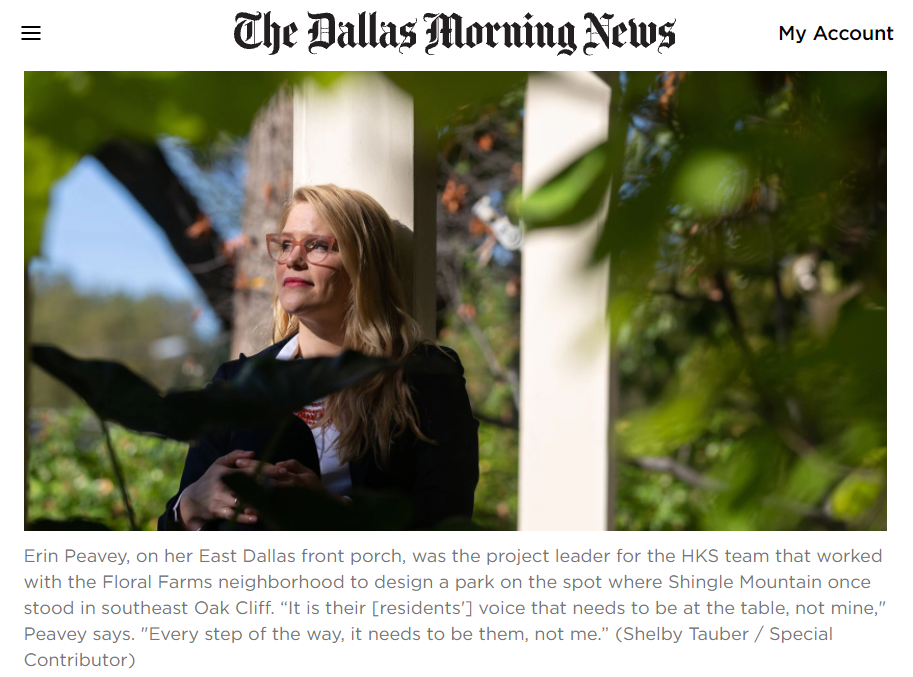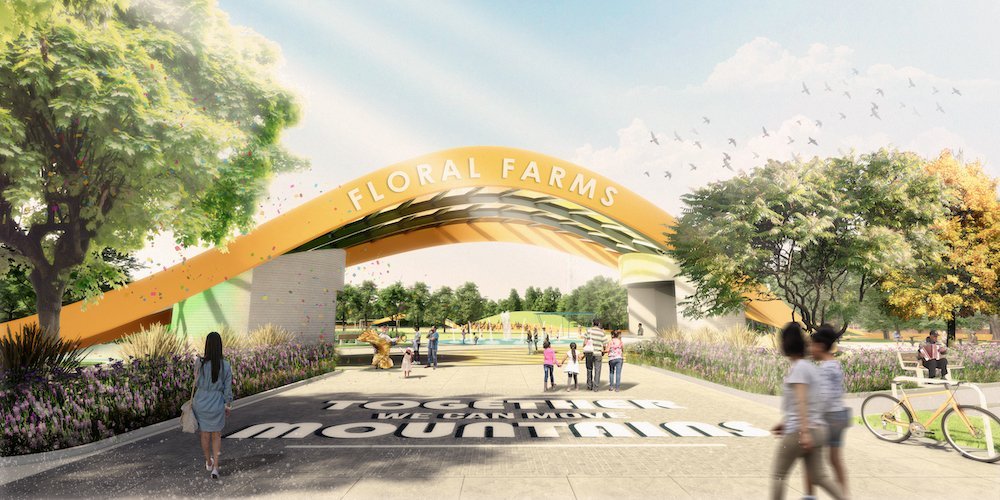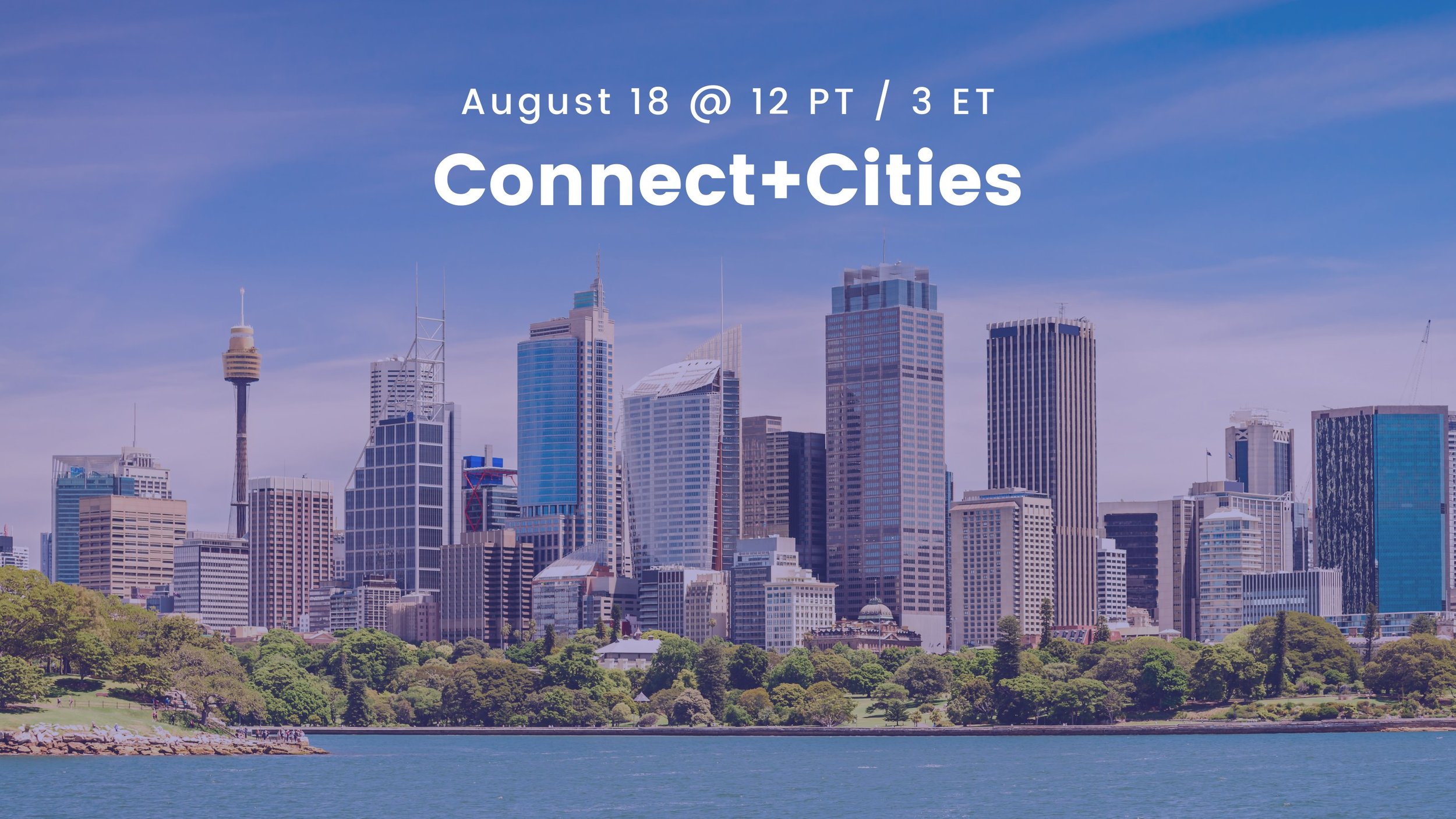Dallas Morning News: ‘A place of community and healing’
‘A place of community and healing’: This Dallas architect led park design for Shingle Mountain site .
‘Together we can move mountains’ is the motto of the park — and of Erin Peavey’s effort to ensure that the Floral Farms neighborhood got the proposal it envisioned.
Hope Comes to Floral Farms: Visions of a Park Where Shingle Mountain Once
“Peavey says she hopes the park project channels some of what made the neighborhood great and provides a place for the residents to be together. That’s where the idea for the community garden came from. The community was also desperate for a soccer field; HKS hopes it will attract teams from across the city while giving the neighborhood somewhere local to play. The second phase of the park will include an equine therapy center, using an existing building on the property.”
Connect + Cities: Foundation for Social Connection and Social Health Labs
Join us for the third event in the Connect+Conversations series! This session will focus on how the places where we live, work, and play influence our social relationships.
We will explore the latest research, recommendations, and real-world examples of designing the built environment and neighborhoods to reduce loneliness and strengthen communities.
You will hear from experts in this space and have the opportunity to engage with people across the US and globally. Join the conversation if you are interested in learning and discussing:
What features of the built environment contribute to social health
How urban vs. rural communities help or hinder social connection
Why design and programming must go hand-in-hand
And more!
Psychology Today: Olympic Proportions
Struggling to balance it all? How to listen to your inner voice and redefine your worth.
Alone Together Podcast
Following the pandemic of 1918, there was an urge to look for new solutions to what we used every day inside our homes. Everything from door knobs to bed frames to toilet seats were redesigned towards a cleaner, more hygienic environment. What will the interiors of houses look like after this pandemic and how and where will we live? Whether it’s a basement suite or a mansion by the beach, our homes are shelters and sanctuaries. But sanctuaries come at a cost. House prices skyrocketed during the pandemic and so did loneliness. It may be scary to go back outside after this pandemic, but greenspace and third places connect us with each other after months of isolation. In this episode, hear from: Uwe Schmidt-Hess, the founder and director of 'Patalab. Since setting up the practice in 2008, he has coordinated the design of a diverse range of projects encompassing the residential, public, office, arts and culture sectors. Prior to establishing Patalab, Uwe worked for several leading international firms including Fink+jocher in Munich, Atrium Design in Bangkok and Make Architects in London. Erin Peavey, an Architect and Design Researcher at HKS. She bridges the gap between research and practice, with a focus on design for health and wellbeing. Erin has been named a Rising Star by Healthcare Design Magazine and Healthcare Design's Best Under 40 by the AIA-AAH. If you like this episode, please subscribe here: https://apostrophepodcasts.ca/alonetogether and follow us on social media @apostrophepod See acast.com/privacy for privacy and opt-out information.
Visible Voices Podcast
I was honored to be in conversation with Jennifer Roberts, PhD and Resa Lewiss, MD on her podcast, Visible Voices talking about the role of the built environment on health.
Psychology Today: Designing for Happiness
Loneliness and social isolation are threatening millions of people; however, increasing connection can reduce risk.
The places we live can exacerbate our sense of isolation and loneliness.
Concrete design strategies—like universal accessibility, incorporation of nature, and shared spaces—can foster social health.
Psychology Today: Is Your Environment Making You Lonely?
Loneliness and social isolation are threatening millions of people; however, increasing connection can reduce risk.
The places we live can exacerbate our sense of isolation and loneliness.
Concrete design strategies—like universal accessibility, incorporation of nature, and shared spaces—can foster social health.
World Happiness Week: Designing for Urban Connection
Partnering with Social Health Lab’s founder, Kasley Killam, MPH from Harvard University, to discuss Designing for Urban Connection as a part of the World Happiness Week events, hosted by Togetherness Hub!
Pandemic-Resilient Healthcare Design
HKS Health and Arup have partnered to share The Pandemic-Resilient Hospital: How Design Can Help Facilities Stay Operational and Safe. In this webinar, we explored detailed architectural, MEP engineering and medical planning strategies to create and adapt facilities to be more resilient to long-range airborne diseases, such as SARS-CoV-2.
An Impromptu Discussion: Architecture and Design Exchange
“done without being planned, organized, or rehearsed.”
In a new series of one on one talks, An Impromptu Discussion aims to re-instill the desire for spontaneous and critical discussion around architecture and design. An Impromptu Discussion will be held every two weeks, hosted by Michael Friebele in partnership with the Architecture and Design Exchange. In the spirit of being “impromptu,” there will be no prepared slides. Each session will cover a number of topics and interests with audience participation in shaping the discussion encouraged.
Erin Peavey Named Building Design & Construction 40 Under 40
Erin Peavey is Named a BD+C 40 under 40 class of 2020
These AEC stars are making their mark in business, philanthropy, and in their communities.
Cornell Keynote: Institute for Healthy Futures - Health and Human Connection
The pandemic has created a new normal of remote living: forcing many of us to move from in-person interactions to online and virtual experiences, heightening feelings of loneliness, disengagement and disproportionately affecting vulnerable and marginalized communities.
Join this event on utilizing health, hospitality and design to reframe human connection, share our humanity, promote inclusion.
Erin Peavey Named an Engineering News Record 2021 Top Young Professional
Erin Peavey was honored to be recognized by ENR Texas & Louisiana at part of the 2021 class of Top Young Professionals. This annual awards program honors 20 individuals under 40 years of age in each of ENR's 10 regions who have shown exceptional leadership and service throughout their career.
National Forum for Black Public Administrators: Forum 2020
Loneliness can affect anyone at any point in life and is a topic that employers should address proactively as it can have a negative effect on workplace productivity and a person’s health. The workplace can serve as the foundation for improving vitality and reducing feelings of loneliness and starts by creating a culture of inclusion.
Speaking at International City Management Association Conference
Loneliness can affect anyone at any point in life and is a topic that employers should address proactively as it can have a negative effect on workplace productivity and a person’s health. The workplace can serve as the foundation for improving vitality and reducing feelings of loneliness and starts by creating a culture of inclusion. But how do you do this in a time of social distancing? Managers and leaders of organizations can lead the way by building connections with their employees and setting a cultural tone of relationship-building and inclusiveness both in the office and virtually. Join us to learn what steps you can take to combat loneliness in your workplace and improve your employees’ health, well-being and productivity. Erin Peavey of HKS Architects will discuss how the built environment is an essential tool in creating a world that is more connected, comforting, and well. By working together with the communities we serve, we can co-create places that foster health.
Cooper Hewitt: Design On The Front Lines
Designing on the Front Lines (DOTFL) is a series of online conversations organized by the Health Design Lab at Jefferson University School of Medicine with Cooper Hewitt, Smithsonian Design Museum. Twelve live sessions were recorded during Summer 2020, as Covid-19 spread to cities and rural areas around the United States and the world. In each episode, doctors, nurses, designers, architects, and other professionals discuss design as a weapon against Covid-19. Topics discussed include designing medical devices and PPE; addressing racism’s role in the pandemic; redesigning patient rooms and emergency departments; and creating new rituals for death and grieving. Delivered via Zoom, the conversations are moderated by Dr. Morgan Hutchinson and Dr. Matthew Fields, emergency physicians and faculty in the Health Design Lab.



















